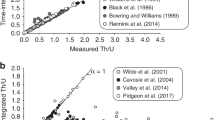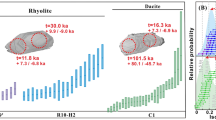Abstract
Mars exhibits ample evidence for an ancient surface hydrosphere. The oxygen isotope compositions of carbonate minerals and alteration products in martian meteorites suggest that this ancient hydrosphere was not in isotopic equilibrium with the martian lithosphere1,2,3,4. Martian meteorite NWA 7533 is composed of regolith breccia from the heavily cratered terrains of ancient Mars and contains zircon grains for which U–Pb ages have been reported5. Here we report variations between the oxygen isotopic compositions of four zircon grains from NWA 7533. We propose that these variations can be explained if the mantle melts from which the zircon crystallized approximately 4.43 Gyr ago had assimiliated 17O-enriched regolith materials, and that some of the zircon grains, while in a metamict state, were later altered by low-temperature fluids near the surface less than 1.7 Gyr ago. Enrichment of the martian regolith in 17O before the zircon crystallized, presumably through exchange with the 17O-enriched atmosphere or hydrosphere during surface alteration, suggests that the thick primary atmosphere of Mars was lost within the first 120 Myr after accretion. We conclude that the observed variation of 17O anomalies in zircon from NWA 7533 points to prolonged interaction between the martian regolith, atmosphere and hydrosphere.
This is a preview of subscription content, access via your institution
Access options
Subscribe to this journal
Receive 12 print issues and online access
$259.00 per year
only $21.58 per issue
Buy this article
- Purchase on Springer Link
- Instant access to full article PDF
Prices may be subject to local taxes which are calculated during checkout



Similar content being viewed by others
References
Farquhar, J., Thiemens, M. H. & Jackson, T. Atmosphere–surface interactions on Mars: Δ17O measurements of carbonate from ALH 84001. Science 280, 1580–1582 (1998).
Clayton, R. N. & Mayeda, T. K. Oxygen isotope studies of achondrites. Geochim. Cosmochim. Acta 60, 1999–2017 (1996).
Karlsson, H. R., Clayton, R. N., Gibson, E. K. Jr & Mayeda, T. K. Water in SNC meteorites: Evidence for a martian hydrosphere. Science 255, 1409–1411 (1992).
Farquhar, J. & Thiemens, M. H. Oxygen cycle of the martian atmosphere–regolith system: Δ17O of secondary phases in Nakhla and Lafayette. J. Geophys. Res. 105, 11991–11997 (2000).
Humayun, M. et al. Origin and age of the earliest martian crust from meteorite NWA 7533. Nature 503, 513–516 (2013).
Agee, C. B. et al. Unique meteorite from early Amazonian Mars: Water-rich basaltic breccia Northwest Africa 7034. Science 339, 780–785 (2013).
Yin, Q-Z. et al. An Earth-like beginning for ancient Mars indicated by alkali-rich volcanism at 4.4 Ga. Lunar Planet Sci. XLXVI, abstr. #1320 (2014)
Ziegler, K. et al. The unique NWA 7034 martian meteorite: Evidence for multiple oxygen isotope reservoirs. Lunar Planet Sci. XLXV, abstr. #2639 (2013)
Romanek, C. et al. Oxygen isotopic record of silicate alteration in the Shergotty–Nakhla–Chassigny meteorite Lafayette. Meteorit. Planet. Sci. 33, 775–784 (1998).
Valley, J. W. Oxygen isotopes in zircon. Rev. Min. Geochem. 53, 343–386 (2003).
Thiemens, M. H. Mass-independent isotope effects in planetary atmospheres and the early solar system. Science 283, 341–345 (1999).
Lunine, J. I., Chambers, J., Morbidelli, A. & Leshin, L. A. The origin of water on Mars. Icarus 165, 1–8 (2003).
Borg, L. E. et al. The age of the carbonates in martian meteorite ALH84001. Science 286, 90–94 (1999).
Gale, N. H., Arden, J. W. & Hutchison, R. The chronology of the Nakhla achondritic meteorite. Earth Planet. Sci. Lett. 26, 195–206 (1975).
Papanastassiou, D. A. & Wasserburg, G. J. Evidence for late formation and young metamorphism in the achondrite Nakhla. Geophys. Res. Lett. 1, 23–26 (1974).
Podosek, F. A. Thermal history of the nakhlites by the 40Ar–39Ar method. Earth Planet. Sci. Lett. 19, 135–144 (1973).
Shih, C. Y., Nyquist, L. E., Reese, Y. & Wiesmann, H. The chronology of the Nakhlite, Lafayette: Rb–Sr and Sm–Nd isotopic ages. Lunar Planet. Sci. XXIX, abstr. #1145 (1998)
Webster, C. R. et al. Isotope ratios of H, C and O in CO2 and H2O of the martian atmosphere. Science 341, 260–263 (2013).
Pepin, R. O. On the origin and early evolution of terrestrial planet atmospheres and meteoritic volatiles. Icarus 92, 2–79 (1991).
Bjoraker, G. L., Mumma, M. J. & Larson, H. P. Isotopic abundance ratios for hydrogen and oxygen in the martian atmosphere. Bull. Am. Astron. Soc. 21, 991 (1989).
Krasnopolsky, V. A., Maillard, J. P., Owen, T. C., Toth, R. A. & Smith, M. D. Oxygen and carbon isotope ratios in the martian atmosphere. Icarus 192, 396–403 (2007).
Lammer, H. et al. Outgassing history and escape of the martian atmosphere and water inventory. Space Sci. Rev. 174, 113–154 (2013).
Jakosky, B. M. & Phillips, R. J. Mars’ volatile and climate history. Nature 412, 237–244 (2001).
Güdel, M., Guinan, E. F. & Skinner, S. L. The X-ray sun in time: A study of the long-term evolution of coronae of solar-type stars. Astrophys. J. 483, 947–960 (1997).
Ribas, I., Guinan, E. F., Güdel, M. & Audard, M. Evolution of the solar activity over time and effects on planetary atmospheres. I. High-energy irradiances (1–1700 Å). Astrophys. J. 622, 680–694 (2005).
Claire, M.W. et al. The evolution of solar flux from 0.1 nm to 160 μm: Quantitative estimates for planetary studies. Astrophys. J. 757, 95–107 (2012).
Elkins-Tanton, L. T. Linked magma ocean solidification and atmospheric growth for Earth and Mars. Earth Planet. Sci. Lett. 271, 181–191 (2008).
Carr, M. H. & Head, J. W. Geologic history of Mars. Earth Planet. Sci. Lett. 294, 185–203 (2010).
Franchi, I. A., Wright, I. P. & Pillinger, C. T. The oxygen isotope composition of Earth and Mars. Meteorit. Planet. Sci. 34, 657–661 (1999).
Rumble, D. & Irving, A. J. Dispersion of oxygen isotopic composition among 42 martian meteorites determined by laser fluorination: Evidence for assimilation of (ancient) altered crust. Lunar Planet Sci. XL, abstr. #2293 (2009)
Acknowledgements
This work has been supported by Knut and Alice Wallenberg Foundation and Swedish Research Council grants to A.A.N. and M.J.W and by grants from NASA to M.H. The Nordsim facility is operated as a joint Nordic infrastructure. This is Nordsim publication 378.
Author information
Authors and Affiliations
Contributions
A.A.N., M.H. and M.J.W. conceived the manuscript, directed the research and wrote the manuscript; R.H.H., J-P.L., M.G. and A.K. contributed to the interpretation of data and the revision of the manuscript; M.J.W. and A.A.N. performed oxygen isotope and U–Pb image analyses; B.Z. and C.F. prepared polished samples for this study; R.H.H. and B.Z. performed petrological studies; D.D., J-P.L. and B.Z. located and imaged zircon by scanning electron microscopy.
Corresponding author
Ethics declarations
Competing interests
The authors declare no competing financial interests.
Supplementary information
Supplementary Information
Supplementary Information (PDF 2621 kb)
Rights and permissions
About this article
Cite this article
Nemchin, A., Humayun, M., Whitehouse, M. et al. Record of the ancient martian hydrosphere and atmosphere preserved in zircon from a martian meteorite. Nature Geosci 7, 638–642 (2014). https://doi.org/10.1038/ngeo2231
Received:
Accepted:
Published:
Issue Date:
DOI: https://doi.org/10.1038/ngeo2231
This article is cited by
-
Geological evidence for multiple climate transitions on Early Mars
Nature Geoscience (2024)
-
A micrometeorite from a stony asteroid identified in Luna 16 soil
Nature Astronomy (2022)
-
Record of low-temperature aqueous alteration of Martian zircon during the late Amazonian
Nature Communications (2019)
-
Geologic Constraints on Early Mars Climate
Space Science Reviews (2019)



